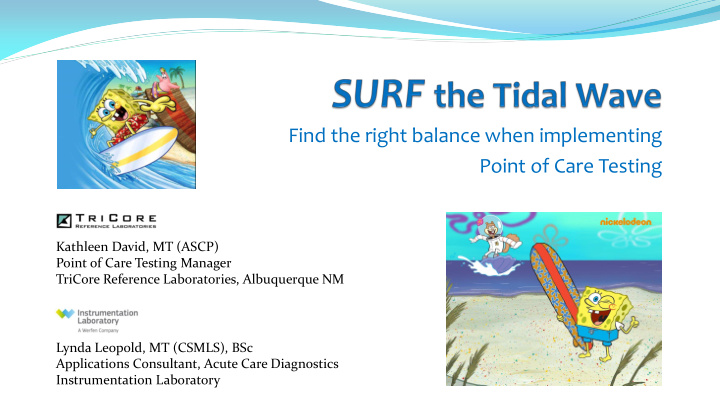



Find the right balance when implementing Point of Care Testing Kathleen David, MT (ASCP) Point of Care Testing Manager TriCore Reference Laboratories, Albuquerque NM Lynda Leopold, MT (CSMLS), BSc Applications Consultant, Acute Care Diagnostics Instrumentation Laboratory
They’re asking for a( nother) POC Test!
Can we talk you out of it? If you know all the requirements, will POCT option still be your choice? Considerations for specific unit requesting testing — workflow, staffing, volume, etc. Does the requester have all the information needed to make an informed decision? Do YOU have all the information needed to make an informed decision?
I want POCT-now what? Developing a process for requests First encounter-Formal? Informal? Paperwork Submission Approvals Who needs to sign off? Are we all on the same page? Plans for implementation
Who assesses the requests? POCT Coordinator (POCC) alone POCC plus lab (medical director) POCT Committee (clinical spectrum — multidisciplinary)
Decision-making models Lab-driven: You Shall vs. Work together to Customer-driven: We Want determine the need and the best way to meet the need vs. Collaborative (optimal)
Designing a form-what to include Standard of care vs. new methodology Existing POCT platforms Availability of interface Quotes and estimating costs Who is responsible for what? What resources are needed to support the test? How does this POCT test improve patient care? Ensure objective assessment
Example form:
The ask vs the Need — part 1 What a unit asks for is not always the same as their need: If a specific analyzer/instrument — Why?? New technology Visit from vendor/seen at trade show Used at previous assignment
You are the subject matter expert-- Anticipate and have your research ready! Peer groups (eg. AACC listserv) Literature Be wary of marketing. Consider your specific situation(s). Look for standardization opportunities Keep up with new testing technology Don’t forget the importance of an interface Ensuring quality result and patient safety should be a priority
The ask vs the Need — part 2 Often the rationale is “lab’s not meeting our TAT needs” Automated environment: not often a true lab TAT issue Workflow analysis: Where are the gaps? Ordering/EMR? Sample? Screen refresh?
Use a formal Root Cause Analysis/ Five Whys to really understand the process Work together to develop standard work/job aids Measure!! “What’s measured, improves” ( Drucker) Try Daily Management/Gemba Will POCT really make things better? Will it really make things faster?
Show Me The Money Costs are so much more than purchasing the instrument! Interface Connections and Licenses-To LIS/EMR/Data Manager Consumables — large purchase up front for validation and competency, extra for QC Oversight: How easy will it be to maintain quality testing? How do you define VALUE? Operator time requirements: What would an operator be upfront and ongoing doing for a patient if NOT POCT? Is that activity a better value? Does your staff *want* to Maintenance contracts add this to their workflow? and Repairs Vendor Relationships: reliability, responsiveness, support
Cost Sharing Who pays for: Instruments? Hardware? Software? Interface? Consumables? Oversight? Who gets paid, by what means, and how much?
On the other hand, cost considerations are not always just the spending POCT may cost more than in lab but can it increase value? • Reduce delay or improve patient flow MRI, Cath Lab, OR • Eliminate need for follow up -Hgb A1C • Triage in the ER • HEDIS measures • Reimbursement targets
Regulatory: Who knew there were so many RULES? Accreditation Body CLIA Complexity CAP? TJC? DNV? Others? Many OR/Cath Lab tests are moderately complex Same requirements as high complexity but not the CLIA primary task of the operator • Who holds the license? Validation, • Do you have the right license? QC or IQCP • Cal/Ver • Correlation • Training • PT • Observation for CLIA six elements
Different Oversight Models Unit-driven: POCT Coordinator (POCC) reviews and asks for corrective action. Vs POCC-led, more lab involvement Who will train new operators? Assess competency? Is there a Technical Consultant qualified person? What about Clinical Consultant?
Maybe YOU want to Implement POCT! Frees up lab FTEs for more complex/value add testing Physician Satisfier/Engagement Align workflows, improve processes Opportunity to show value or collect data Patient Satisfier Specialty/boutique testing
KEEPING UP WITH NEW TECHNOLOGY POCT methodologies continue to evolve Molecular infectious disease testing Lab on a chip Novel methods for resource-constrained applications Non-invasive testing Drugs of Abuse — fingerprints! Microdialysis Smartphones??
It’s not going away… Better technology-improving towards gold standard Faster, cheaper Remote monitoring options Marketing to clinicians Staying up-to-date will best serve your organization
There are opportunities Data collection for clinical decision support Population Health HEDIS measures reports CMS value-based reimbursement PAMA Sepsis Protocol
In Summary Can we talk you out of it? Develop a process-use data and be objective The ask vs the need Costs, revenue and benefits Regulatory Maybe it helps YOU It’s not going away
ANY QUESTIONS? kathleen.david@tricore.org lleopold@ilww.com
Recommend
More recommend